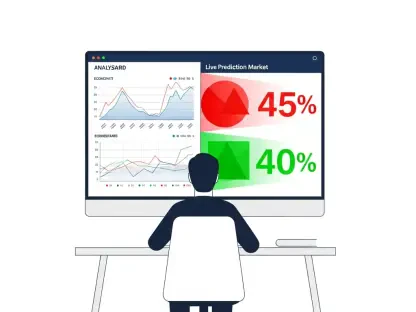The merger between ABVE and Palm Global Technologies represents a significant transformation for ABVE, moving it from a niche agricultural company to a prominent player in the financial technology sector. With its newly acquired 30% stake in Palm Promax Investments, which controls substantial gold-backed assets, ABVE is poised to dominate stablecoin markets. This strategic expansion provides ABVE with access to sovereign assets worth over $1.5 trillion. This transition marks a new era in the digital asset finance space, emphasizing the role of asset-backed credibility and blockchain innovations in redefining financial ecosystems.
Strategic Shift and Expansion
From Agriculture to Finance
ABVE’s transition from agricultural ingredients to a fintech leader is driven by the strategic acquisition of key assets. By leveraging an extensive $350 billion in gold-backed sovereign reserves, the company strengthens its foundation for stablecoin issuance. Sovereign-backed assets offer inherent stability important to the digital finance realm. Gold, with its historic value stability, serves as robust collateral for stablecoins, enhancing their credibility in cross-border transactions and liquidity management. ABVE’s merger strategically positions the company against decentralized options such as DAI or USDT by offering asset-backed stability. This approach aligns with regulatory standards seen in legislative frameworks like the U.S.’s GENIUS Act and the EU’s MiCA, which prioritize transparency and reserve backing, thus attracting institutional investors seeking minimized counterparty risk.
Regulatory Alignments and Technological Advancements
The merger introduces a hybrid infrastructure that merges AI-driven blockchain technology with a multi-sector super-app platform. This convergence enables ABVE to transform physical commodity contracts into tradable digital instruments. With scalability, ABVE is set to involve numerous sovereign nations in developing frameworks for central bank digital currencies (CBDCs). This approach strengthens ABVE’s role as a bridge between traditional finance and emerging Web3 paradigms. For instance, tokenizing farmland provides farmers liquidity opportunities while allowing retail investors fractional ownership of tangible assets. The synchronized growth of blockchain innovations and regulatory clarity serves as a catalyst for institutional adoption, aligning seamlessly with ABVE’s strategic alliances with sovereign nations to promote its stablecoins in developing economies.
Leadership and Infrastructure
Engaging Expertise for Scaling Success
The leadership behind ABVE’s expansion plays a pivotal role in its strategic execution. With Peter Knez, former Co-CIO of a major financial institution, at the helm, the company aims to replicate the transformation seen in the ETF industry involving tokenized assets. Knez’s expertise aligns with ABVE’s aspiration to scale its offerings, capitalizing on the evolving regulatory landscapes in the U.S. and EU, which have clarified some uncertainties. This clarity facilitates faster adoption rates of innovations in digital finance. Additionally, collaborations with sovereign entities provide geopolitical leverage and encourage the adoption of ABVE’s stablecoins within economies still defining their digital currency frameworks.
Competitive Landscape and Growth Potential
ABVE steps into a competitive market dominated by fiat-collateralized stablecoins like Tether (USDT). However, ABVE differentiates itself by backing its tokens with sovereign-owned gold assets, creating a strong value proposition. This backing enhances trust among investors and allows for faster scalability compared to competitors. With access to $1.5 trillion in tokenizable assets, ABVE stands to gain substantial ground. As analysts foresee the tokenized asset market expanding to $13.55 trillion by 2030, ABVE is positioned to capitalize on this growth. The company’s physical asset backing provides a competitive edge, bolstering its credibility and appeal to institutional investors.
Navigating Challenges and Opportunities
Execution Risks and Regulatory Challenges
Transitioning from agricultural roots to fintech introduces inherent challenges, particularly in integrating diverse business operations and adhering to evolving regulatory standards. Concerns about leveraged debt and negative equity, existing prior to the merger, call for meticulous financial management. However, the merger’s equity infusion from share issuance to Palm Global shareholders bolsters ABVE’s financial stability, partially alleviating these concerns. The careful navigation of execution risks paired with strategic regulatory alignment ensures robust growth prospects. Addressing these challenges effectively will enable ABVE to fortify its position in this new market landscape.
Strategic Outlook and Future Potential
The recent merger between ABVE and Palm Global Technologies signifies a monumental shift for ABVE, transitioning it from a specialized agricultural firm to a significant entity in the financial technology sphere. By securing a 30% stake in Palm Promax Investments, ABVE gains control over substantial gold-backed assets. This move strategically positions ABVE to lead in the stablecoin markets, propelling its influence within the digital asset finance industry. The merger grants ABVE access to sovereign assets exceeding $1.5 trillion, marking a pivotal transformation in their business model. This shift underscores a new era where asset-backed credibility and blockchain innovations are crucial in reshaping financial ecosystems. The fusion of traditional asset security with cutting-edge blockchain technology offers new opportunities for growth and stability in financial markets, setting a precedent in the convergence of macroeconomic resources and digital advancements. This could potentially redefine how industries approach digital finance.









